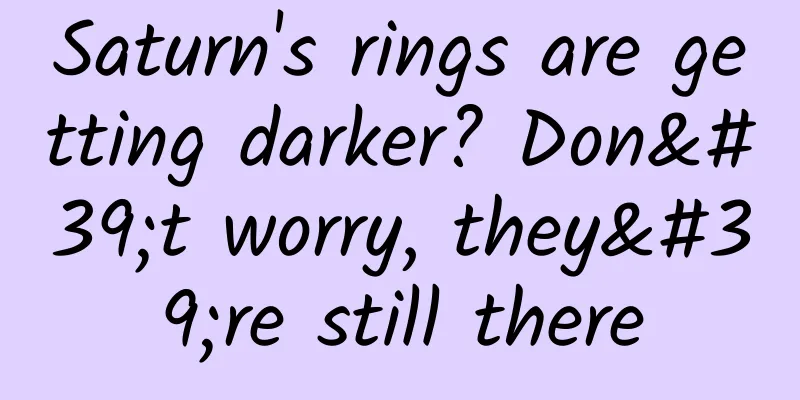Saturn's rings are getting darker? Don't worry, they're still there

|
Author: Zeng Heng Duan Yuechu On the stage of the vast universe, Saturn's rings are undoubtedly one of the most eye-catching celestial landscapes. They are like dazzling ornaments carefully crafted by the universe, surrounding Saturn and exuding a mysterious and charming atmosphere. However, did you know that these magnificent rings sometimes quietly disappear from our sight? On January 23, 2025, Saturn's rings will appear almost edge-on, barely perceptible, from Earth. I noticed this recently when I was admiring Saturn near brilliant Venus in the southwestern night sky. Compared to Venus, which is so bright that it's often mistaken for an airplane or UFO, anything close to it will appear dim, but Saturn looks especially dim. Not only is it slightly dimmer than usual because it's nearly on the other side of the sun, at its greatest distance from Earth, but Saturn's dazzling rings are disappearing from our view. The normally broad rings now appear unusually thin, almost like a line across the planet. Without the countless reflective ice particles that add to Saturn's brilliance, the planet appears less than half as bright as it would otherwise. But rest assured, Saturn's magnificent rings are still there. They're barely visible for two reasons: first, they're incredibly flat, and second, our viewing angle is affected by the respective orbital motions of Saturn and Earth. Saturn's rings are not only the planet's most striking feature, they're arguably the most spectacular structure in the entire solar system. The main rings are about 280,000 kilometers in diameter, and if they were placed between the Earth and the Moon, they'd cover more than two-thirds of the distance! Despite their size, they're barely visible to the naked eye, with Saturn more than a billion kilometers away. Once humans began scanning the sky with telescopes, though, the rings were discovered, even though their true structure remained a mystery at the time. In the early 17th century, Galileo saw Saturn's rings through his crude telescope, but because the resolution was insufficient to see their true shape, he called them Saturn's "ears." Decades later, Dutch astronomer Christian Huygens realized that the planet was surrounded by a ring that "does not touch it anywhere," as he wrote in his book "The Saturnian System." Famous physicist James Clerk Maxwell, who determined the equations of electromagnetism that underpin modern technological civilization, was the first to prove that such a ring could not be solid, otherwise it would be torn apart. The inner edge of the ring would rotate around Saturn much faster than the outer edge, which would shatter it. From this, it follows that Saturn's rings must be made up of small pieces of material that are too small to be seen by any telescope on Earth. More modern observations show that these small pieces are almost pure water ice, which is why they are so bright, because ice is an excellent reflector of sunlight. Modern research also shows that most of these small pieces are smaller than the average car and there may be as many as quadrillions of them. Regarding the formation of the halo, it is generally believed that it may have been formed when one of Saturn's icy satellites was violently hit by an incoming object, which may even be another satellite. Interestingly, it is not clear when this event occurred. A study published in the journal Icarus in 2023, by observing the accumulation rate of dark micrometeorite dust on the originally shiny halo, found that from a cosmic perspective, the halo is very young, only between 100 million and 400 million years old. However, research published in the journal Nature Geoscience at the end of 2024 found that the rate of "pollution" of this dust is not as fast as previously thought. High-speed micrometeorite collisions ionize ring particles and give them an electric charge, which makes them susceptible to Saturn's strong magnetic field, which in turn attracts matter away and slows down the darkening of the halo, which means that the halo may be much older. Even now, centuries after their discovery, the rings still hold many mysteries. However, we have a relatively clear idea of how they formed after the initial collision, which explains why they are so flat, although their age remains a mystery. Due to the orbital motion of Saturn's moons and its impactor, the debris would have initially formed into a long stream, with much of it probably along the direction of the moon's orbital motion. Saturn's other moons orbit above its equator, so material from this moon could have ended up in a similar structure. In addition, because Saturn is not a perfect sphere, but rather bulges at the equator due to its rapid 10.5-hour rotation, the planet's thickened middle would have twisted the debris into an orbit just above the equator, which is why the impact that created the rings formed a flat disk. And by flat, we mean incredibly flat. Although the rings are hundreds of thousands of kilometers in diameter, they are extremely thin, spanning no more than a kilometer vertically. In some places, the rings are only 10 meters high, the height of a three-story building. As huge as the rings are, if you shrunk them and Saturn itself to a diameter of 28 centimeters (11 inches), the length of a standard sheet of paper, the rings would be 100 times thinner than paper! Finally, gravitational interactions with Saturn's large moons push the ring particles into slightly different orbits. Over time, they form thousands of individual rings, with some gaps in between. So the rings are stunning when viewed from above, but razor-thin and extremely difficult to see when viewed from the side. This is the situation we find ourselves in right now. Like Earth, Saturn's axis of rotation is highly tilted, more than 26 degrees from the ecliptic plane in which all the major planets orbit (Earth's tilt is 23 degrees). This means that during Saturn's northern summer, its north pole is tilted toward the Sun. From Earth, which is closer to the Sun than Saturn is, we look "down" at the rings and see them in their entirety. Saturn orbits the Sun every about 30 years, so the rings are clearly visible to us for most of Saturn's year. However, during Saturn's spring and autumn equinoxes, the rings appear much more edge-on from Earth, and in fact appear completely edge-on when viewed from the Sun. But because Saturn's orbit around the Sun is slightly tilted relative to Earth's orbit, we can only see the rings edge-on at Saturn's equinoxes if Earth also passes through the plane of the rings. This can happen twice near the equinoxes, with Earth first crossing the plane "up" and then again about six months later crossing "down," which effectively removes Saturn's rings from our view. May 2025 will mark Saturn's autumnal equinox. On March 23, our planet will pass through the plane of the rings, at which point the rings will reach their apex of disappearance before slowly reentering our field of view. But it should be noted that on that date in March, Saturn will be only 10 degrees from the Sun in the sky, making observations very difficult. Bad timing! Although Saturn will cross Earth's orbital plane again in mid-November, by then, Saturn's axial tilt will cause the rings to be slightly tilted from our perspective, so we will only see them very close to edge-on. The good news is that Saturn will be easily observable in the southern sky after sunset in November, and the rings will still be barely visible through a telescope. Check to see if there are any observatories or astronomical societies nearby holding observations! References: Plait, P. (2025, January 23). Saturn's Rings Are Disappearing—But They'lScientific American |
>>: Ancient Technology | Liangzhu’s ancient jade-making method is super “healing”!
Recommend
5 dimensions to create true “native advertising”
People watch what they want to see, and sometimes...
The ancient cypress tree reborn from the ashes, the ancient locust tree standing for a thousand years... Take a look at the unique ancient trees in the hometown of Confucius and Mencius!
Produced by: Science Popularization China Author:...
November marketing hotspot calendar!
The National Day holiday has just passed, and the...
How much does it cost to develop a Huizhou property app? What is the price for developing a Huizhou property app?
The factors that affect the quotation of Huizhou ...
How to develop a successful online event planning plan?
This article mainly talks about how to develop a ...
How to rent a server cabinet?
How to rent a server cabinet? The rental of a ser...
Some useful UX/UI design tools and download addresses abroad
The design tools you use today may no longer be s...
Wang Zhanan Virtual Resource Project 2.5, Transaction and Conversion of Virtual Resource Project on April 20 (Completed)
1.2 How to find your own position.mp4 1.3 How to ...
How to improve user retention rate? 6 strategies used by the entire Internet finance industry
This article will use the Internet finance indust...
Samsung S6 in iPhone's underwear reveals six surprises
Many details about Samsung's latest smartphon...
The sluggish iPhone demand hits partners hard; the fourth supplier lowers its earnings outlook
As speculation about lower-than-expected iPhone d...
There is nothing that a good night’s sleep can’t solve. Is there actually a scientific basis for this?
Whenever something annoying or sad happens, your ...
QQ has a new BUG, your password becomes "123456789"?
I believe that serious and studious friends shou...
You will know the high-quality Baidu promotion account structure after reading this article...
Baidu search keyword bidding is a very common pro...
The second round of 51CTO developer community administrator recruitment has been successfully completed
[51CTO.com original article] Thank you very much ...









